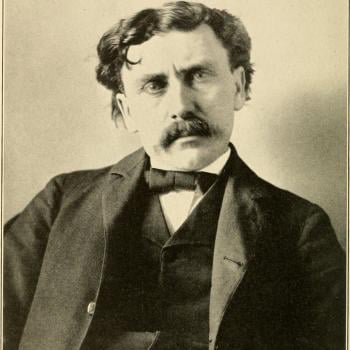Reading Robert Graves’s 1946 novel King Jesus is like undertaking an archaeological dig into intellectual history, as each new layer we excavate reveals changing ideas about Jesus and the Early Church. What makes the book so valuable is that it appeared on the eve of a thrilling new wave of discoveries – Nag Hammadi, the Dead Sea Scrolls – so that we see just how much was known and speculated about on the eve of those new revelations.
I have already posted about Graves’s thoughts on the Essenes. He knows everything there was to be known from ancient authors about that sect, and related sects like the Therapeutae, but he also throws in speculations of his own that in retrospect sound quite prophetic. He suggests, for instance, that one sect of the Essenes was the Ebionites, whom we know as a later Jewish-Christian sect. Graves, though, sees them as a pre-Christian movement.
Like many modern thinkers, Graves believed that much of the authentic truth about Jesus’s life and ministry had been preserved by early sects that were later dismissed as heretical, especially the Ebionites. Such Jewish-Christian movements, he suggests, kept alive the authentic vision of the true Jesus long after he had been so misrepresented by the sinister Paul. In fact, Graves’s fictional narrator Agabus describes how he had become an authority on Jesus in the first place:
An old, sick Ebionite bishop who took refuge in my house at Alexandria during the persecutions volunteered to make me the repository of what he claimed was the only pure Chrestian [sic] tradition….. He cried bitterly, ‘The traitors of Rome and Syria defile the holy truth and make a monster of him whose memory I honor above all others and whom I would have the whole world likewise honor.’
For Graves, the story of early Christianity was a series of stages by which the Jesus Movement lost its Jewish roots as it evolved into a Gentile mystery cult. He re-Judaizes Jesus by means of some ingenious rewriting of the Gospels, which he presents as restoration to the original meaning. In the process, he makes some shrewd comments on the creation of the gospel texts. Whenever Jesus, for instance, makes remarks that make him sound divine, then clearly (says Graves) he is speaking as a prophet and attributing these words to God, and the text should properly begin with a phrase like “Thus says the Lord.” On other occasions, Jesus is credited with words that had originally been spoken by a sage like Hillel or Shammai, and the text should properly restore that attribution.
You don’t have to accept any of his proposed reconstructions in order to find them provocative. As I say, they also indicate how many of those views were commonplace in the 1940s.
In the matter of the Ebionites in particular, Graves was in no sense unique in his views, nor indeed was he terribly innovative. The Ebionites and other Jewish Christian sects were well known in early patristic sources, and the idea that they had kept alive the authentic core of Jesus message was thoroughly familiar to Enlightenment scholars like John Toland. But again, Graves popularized these notions, and brought them to a mass market, long before the Dead Sea Scrolls were known.
Far from being a breakthrough discovery of strictly modern scholarship, the possible Essene/Ebionite/Christian link was already the subject of much debate in nineteenth century European scholarship, and was discussed by J. B. Lightfoot in the 1870s. Largely, scholars pursued these Jewish sectarian links in search of the origins of the idea of baptism. Lightfoot for instance speaks of “those Judaizing Christians who reproduced many of the Essene tenets, and who both theologically and historically may be regarded as the lineal descendants of this Judaic sect.” He calls the Clementine Homilies “an Ebionite work which exhibits many Essene features.”
As so often in early scholarship, many of the most interesting observations are found in Lightfoot’s dense and incredibly erudite footnotes. Economist F. J. Fisher once remarked that “The archetype of the learned monograph consisted of a thin rivulet of text meandering through wide and lush meadows of footnotes”! In one note, Lightfoot refers to the Elchasaite movement, about which I have posted before, and which he places in the context of “Essene Ebionism,” an intriguing phrase. He even wonders “whether the name Elchasaism is coextensive with Essene Ebionism or not.”
A lot of modern literature about the origins of Dualism and Manichaeanism actually grounds itself in the literature on Essenes and Jewish-Christians, especially the Ebionites, with John the Baptist as a pivotal figure. Elchasaites also appear frequently, and we now know that Mani’s family actually adhered to that sect.
Again, we see that our contemporary scholarly insights are not quite as radically new as we might think.
From an immense literature, see J. Carleton Paget, “Jewish Christianity,” in William Horbury, W. D. Davies and John Sturdy eds.,The Cambridge History of Judaism Volume 3: The Early Roman Period (Cambridge University Press, 1999), 731-775. Also in the same volume, see Kurt Rudolf, “The Baptist Sects,” 471-500.
I am just reading the wonderful collection of essays on Elchasaites, Ebionites and related topics in F. Stanley Jones, Pseudoclementina Elchasaiticaque inter Judaeochristiana (Leuven: Peeters, 2012).












